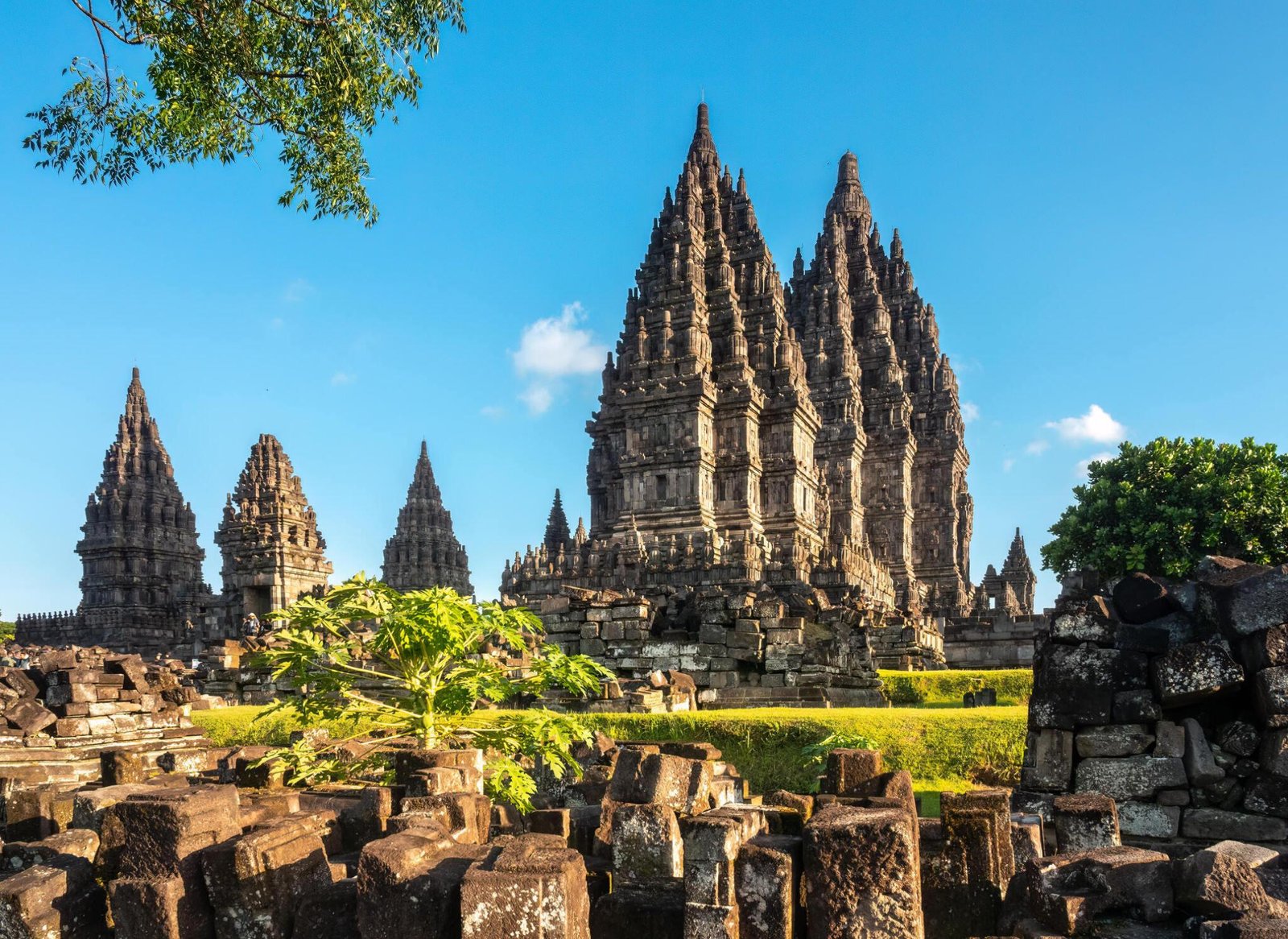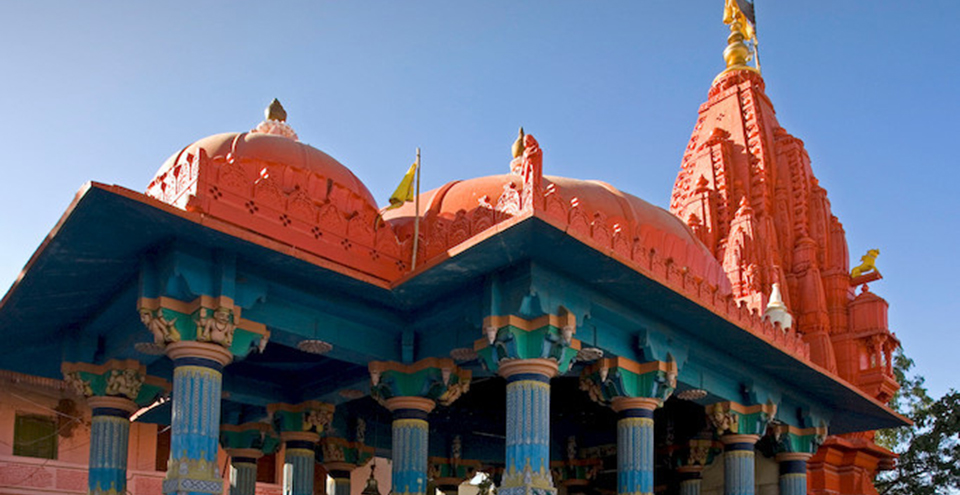
It is said that if some event is written in destiny then the entire universe unites for its happening. If you don’t believe me, consider this incident that happened to me. I was visiting Yogyakarta in Indonesia and was planning a sunrise tour of Borobudur Temple the next day. I gave this information on Twitter. Immediately I got a reply from Narendra Ramakrishnaji in which he advised me to visit the Prambanan temple complex also. He advised that the Prambanan temple complex, located just 20 minutes away from Borobudur, takes less than 2 hours to visit and it would be unfair to oneself to return without seeing it.
I did some research and also discussed with my Indonesian host. The issues got resolved one after the other and finally on my birthday I got the gift of seeing both the temples. In the morning I visited Borobudur and by afternoon I was standing in front of the Prambanan temple complex. Fellow bloggers from Australia, New Zealand and Indonesia were also present with me.
I had limited information about the Prambanan temple complex. So all the way I learned more about him from books. After reaching there, I had mistakenly purchased a domestic passenger ticket instead of an international passenger ticket, hence I was a little nervous due to apprehension. Later I came to know that the foreign passenger ticket is almost 10 times more expensive but a free coffee is also available with it. Luckily I had already had a delicious coffee.
READ ALSO : Polonnaruwa – Sri Lanka’s best ancient city
Prambanan Temple Complex
The first thought that strikes you as you approach the Prambanan temple complex is its vastness. The shikharas of the three tall temples rise above the rest of the temple complex. The rest of the temples appear dwarf in comparison. As you approach them, dark gray stone debris is visible at many places. These ruins are the present form of temples that once stood.
According to legends there were a total of 999 temples in the Prambanan temple complex. However, according to architects, there is evidence of the existence of only 240 temples.
The structure of this temple resembles the outline of Sriyantra. There is a Shiva temple in the middle and Brahma and Vishnu temples on both sides. Each temple also has shrines for the vehicles of the Lord, namely Nandi the bull, swan and Garuda. There are two more temples between the temples of Brahma and Hans and similarly between the temples of Vishnu and Garuda. These are called Apit temples. According to my Indonesian friend, Apit means middle. I could not find any information to whom this temple is dedicated.
The three main and largest temples of the complex are dedicated to the three idols of Hinduism, namely Lord Brahma, Vishnu and Lord Shiva. The Shiva temple in the middle is called Shivagriha or Shivalaya, the abode of Lord Shiva.
Prambanan Trimurti Temple
Here I would like to give you some detailed information about the three main temples.

Shiv Temple
Shiva temple is the largest temple of Prambanan. This reflects the fact that the builders of the Prabanan temple were devotees of Shiva. However, the presence of Brahma and Vishnu temples indicates that all three deities were worshiped in 9th century Java, when this temple was built.
To reach the sanctum sanctorum of the Shiva temple one has to climb steep stairs. The outer walls of the temple have sculptures but the inner walls are plain. It cannot be said with certainty whether it was already simple or it has become like this after repair. The sanctum sanctorum of the temple is small and no system of pavilion and agrashala was visible.
There is a tall statue of Shiva above a lotus flower placed on a square yoni. That is, anthropomorphic Shivalinga is established here. Seeing the statue of Shiva wearing clothes reminded me of the paintings of Buddha of Gandhara style in India.
The ornate underwear on the Shiva statue is long till his ankles and he is wearing thick anklets on his feet. The arms of the four-armed Shiva statue are broken, so it is impossible to guess what he was holding in his hands. His matted hair is tied on top of his head and a snake is wrapped around his neck.
circumambulation path
There is a circumambulation path to circumambulate the sanctum sanctorum. On the walls on both sides of this path, i.e. on the outer wall of the sanctum sanctorum and the inner wall of the palisade, there are sculptures on which narrating the stories of Ramayana have been done.
Here the sculptures on the walls of Shiva and Brahma temples are based on Ramayana and the sculptures of Vishnu temple are based on Bhagwat Purana. It was a bit surprising to see whether people were unaware of the stories of Shiva at that time. Why didn’t they make sculptures telling stories of Shiva on the blocks of Shiva temple? Did they want to tell stories of God’s humanity only? Because it is believed that Ram and Krishna, being human beings, are a part of our history.
Hence, the main and presiding deity of this complex is Shiva, yet stories of Vishnu are seen everywhere.
There are hourglass shaped statues on the walls of the temple. At first glance it appears to be a Vratanushti Stupa or a Stupa of vows. Possibly it may also be a complete component. If anyone knows any alternative meaning of this bell shaped top, I would be interested to know.
A large Kirtimukha is carved at the entrance of the temple, just like the Borobudur temple.
Nandi Temple
Nandi temple is situated right in front of Shiva temple. Its structure is like that of Shiva temple but is much smaller than that. There is a huge stone bull inside the temple. These stones are polished in such a way that it appears to be a real bull.
There are statues of Moon and Sun on both its sides. It cannot be said with certainty whether these two statues belong to this temple or were placed later.
Vishnu Temple
The Vishnu temple is slightly smaller than the Shiva temple, but their structure is similar. A tall narrow temple with a pointed peak, made of dark gray stones!
All the symbols of Vishnu are present on the statue of Vishnu. He holds conch, disc, mace and lotus in his four arms. He stands on a lotus which is placed over a yoni. This seemed very unique to me. Once again I can’t say for sure whether this was the practice here or a mistake during the repair. The similarity between the statues of Shiva and Vishnu is that both the statues are standing on a lotus flower placed on the vagina.
The sculptures on the circumambulation path of this temple depict stories from the Bhagwat Purana.
Garuda Temple
In front of the Vishnu temple is the temple of Garuda, the vehicle of Vishnu. Unfortunately, the idol of Garuda is not present inside it and the temple is vacant. Despite this, a strange thing is felt on visiting this complex, that is that God is seated in his abode and has kept his vehicles in the vehicle room outside.
Brahma Temple
When I was visiting Prambanan Temple, the repair work of Brahma Temple was going on. That’s why I could not enter the temple. Later I collected information related to Brahma’s idol from external sources like Google etc. Here also the three-faced idol of Brahma is situated on a lotus flower placed on the vagina.

Hans Temple
The temple of Hans, the vehicle of Brahma, is situated just in front of the Brahma temple.
Apart from these, the rest of the temples have turned into ruins. But the ruins have been collected in a planned manner at the original place of the temples.
History of Prambanan Temple
Prambanan is the largest temple complex on the island of Java in Indonesia. It was probably constructed by the Sanjay dynasty in the 9th century AD. After this, Buddhism was followed due to the Shailendra dynasty, the builders of Borobudur temple. Mataram kings further enhanced their beauty.
Opak river flows behind this temple. It is said that for the construction of this temple the direction of the Opak River was changed.
It is estimated that this temple was abandoned in the 10th century AD when the volcano of Mount Merapi started erupting and the kingdom was displaced from here. After this, due to many volcanoes and earthquakes, this temple further deteriorated. However, it was unaffected by the volcanic eruption in November 2010 because the lava flowed in the other direction.
Like Borobudur Temple, Prambanan Temple was also discovered by Thomas Stamford Raffles. Yogyakarta will always be grateful to him for discovering his heritage. After discovery, repair work was done on most of the temples which is still going on.
This temple is also called Chandi Prambanan. Chandi means temple in Javanese language.
Famous Roro Zongreng Legends of Prambanan Temple
In Javanese language, unmarried noble women are called Rara or Roro. Many stories and legends related to the war between the neighboring Penging State and Boko State are famous. The Penging prince is said to have killed the Boko king. After this, seeing the mourning princess there, the prince was fascinated by her beauty and proposed her for marriage. After much persuasion, the princess agreed to the marriage on two conditions. The first condition was to build a wall and the second condition was to build 1000 temples, that too in just one night! The love-struck prince accepted both the conditions.
Using his supernatural powers the prince built 1000 temples in one night. The princess, who in her conscience was not ready for this marriage, made a move. She asked her maids to light a fire and make a lot of noise so that the spirits under construction would sense the breaking of dawn and postpone the work. As soon as the prince got to know about this deception, he got angry and cursed the princess and turned her into a stone.
It is believed that the princess still resides in Shila in the form of Kumari Devi and is busy in the construction of the final temple.
Does this story remind you of Kanyakumari?
Ramayan performance in Prambanan
Ramayana in the form of Javanese dance drama is performed on the Trimurti outdoor stage on the banks of river Opak. I have a strong desire to see the Ramayana staged every Purnima and then go to Prambanan. The thrill of watching this Ramayana amidst these temples and ruins, under the full moon, will be incomparable. Probably this is the oldest story in the world which is shown by Ramayana.